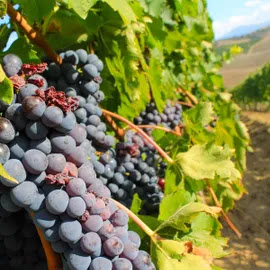While doing a bit of spring cleaning in my cellar, I unearthed a bottle of 2014 Vignobles Levet Côte Rôtie Les Journaries. Medium garnet in color, the wine was floral and full of black fruits on the nose. Acidity was very high, and body was medium plus. On the palate, it was elegant with well-integrated tannins, a savory note, and an incredibly long finish. While savoring this gem, I decided to dig into what makes Côte Rôtie so special.
 |
| 2014 Vignobles Levet Côte Rôtie Les Journaries |
Roasted Slope and Racy Grapes
Located on the northernmost end of the Rhône Valley wine region in France, Côte Rôtie is often translated to the Roasted Slope. This is attributed to the steep slopes or hillsides that rise up to 1,150 feet (over 330 meters) off the banks of the Rhône River, allowing for maximum sun exposure on the vineyards.
In some areas, the sharp incline gets up to 60 degrees. That with the constant risk of erosion bring unique challenges to vine growing. Vineyards are planted in terraces. Since there is no way to use tractors and other machinery on the slopes, tending to the vines and grape harvesting have to be done by hand.
 |
| Côte Rôtie by Olivier Lemoine via Wikimedia Commons |
The grapes grown in the region are mostly Syrah and a small amount of Viognier. With 224 hectares (or 550 acres) of vineyards, Côte Rôtie is one of the smallest appellations in the Rhône Valley. It is about a third the size of Walla Walla Valley and only about 1.2% the size of Napa Valley.
To qualify as Côte Rôtie AOC (Appellation d'Origine Contrôlée), the wine needs to be made with predominantly Syrah and up to 20% of Viognier. The rules also require that the grapes be co-fermented rather than fermented separately and blending afterwards. It is believed that the co-fermentation with Viognier, a white grape, stabilizes the color of Syrah and also adds a floral note to the savory wine.
The Brunette or the Blonde
There are two main hills in Côte Rôtie where some of the best wines are made. According to folklore, a feudal landlord gifted his two daughters each a hill. The hill that went to the dark-haired daughter is known as Côte Brune while the hill that went to the light-haired daughter is called Côte Blonde.
 |
| Brunette and Blonde by Mārtiņš Zemlickis on Unsplash |
The soil of Côte Brune is mostly reddish-brown mica schist and is rich in iron. Côte Brune is often made with 100% Syrah. The wine tends to be tannic, structured, and powerful with good aging potential. Côte Blonde has pale yellow gneiss soil that is similar to granite. It is more likely to be co-fermented with Viognier. The wine is lighter, fruitier, and more approachable when enjoyed young.
But why pick a Blonde or a Brune when you can have the best of both worlds? Renowned Rhône winery and négociant, Guigal, has you covered with its Brune et Blonde that retails for around US$70 a bottle. Feeling spendy? For about twice the price, you can get Guigal’s higher-end Château d'Ampuis, that is made with grapes from seven select terroirs on both hills. Château d'Ampuis is known to be incredibly perfume-y and combines muscle (from Brune) and elegance (from Blonde) beautifully.
The La Las |
| Guigal vineyard in Côte Blonde |
 |
| Guigal’s La La wines |


























